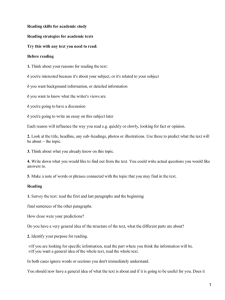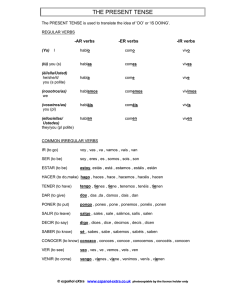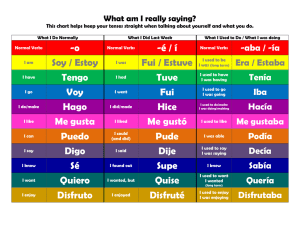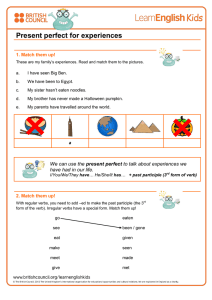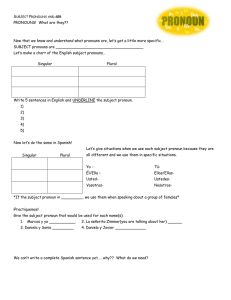I-2014 DOCUMENTO: Programa de curso semestral C
Anuncio
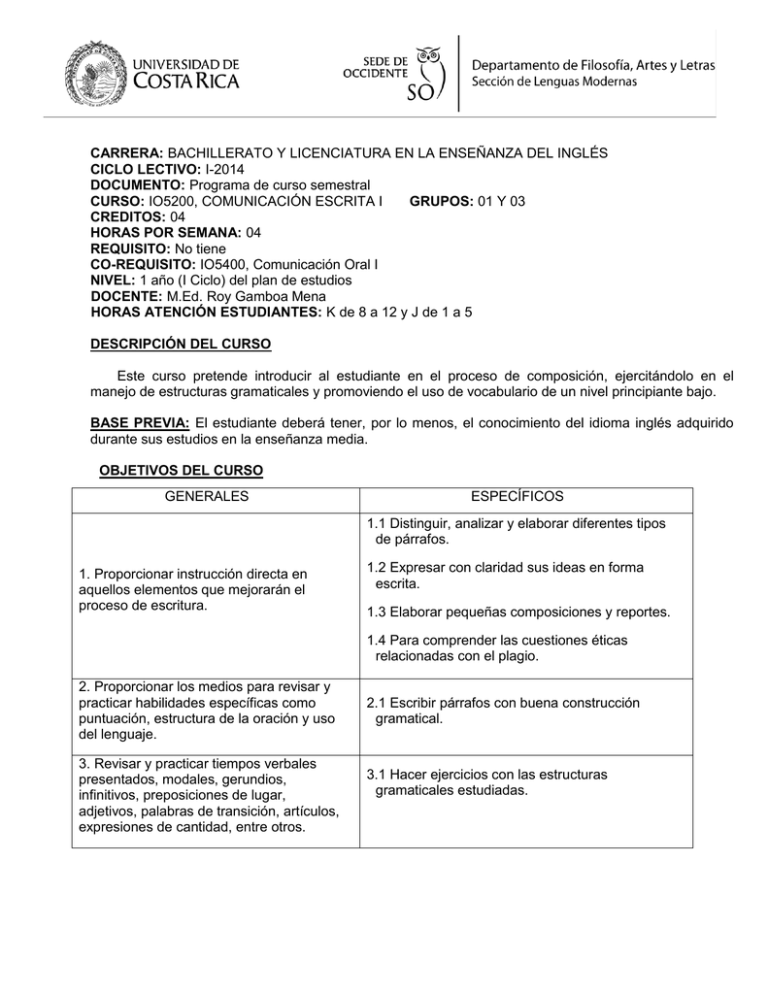
CARRERA: BACHILLERATO Y LICENCIATURA EN LA ENSEÑANZA DEL INGLÉS CICLO LECTIVO: I-2014 DOCUMENTO: Programa de curso semestral CURSO: IO5200, COMUNICACIÓN ESCRITA I GRUPOS: 01 Y 03 CREDITOS: 04 HORAS POR SEMANA: 04 REQUISITO: No tiene CO-REQUISITO: IO5400, Comunicación Oral I NIVEL: 1 año (I Ciclo) del plan de estudios DOCENTE: M.Ed. Roy Gamboa Mena HORAS ATENCIÓN ESTUDIANTES: K de 8 a 12 y J de 1 a 5 DESCRIPCIÓN DEL CURSO Este curso pretende introducir al estudiante en el proceso de composición, ejercitándolo en el manejo de estructuras gramaticales y promoviendo el uso de vocabulario de un nivel principiante bajo. BASE PREVIA: El estudiante deberá tener, por lo menos, el conocimiento del idioma inglés adquirido durante sus estudios en la enseñanza media. OBJETIVOS DEL CURSO GENERALES ESPECÍFICOS 1.1 Distinguir, analizar y elaborar diferentes tipos de párrafos. 1. Proporcionar instrucción directa en aquellos elementos que mejorarán el proceso de escritura. 1.2 Expresar con claridad sus ideas en forma escrita. 1.3 Elaborar pequeñas composiciones y reportes. 1.4 Para comprender las cuestiones éticas relacionadas con el plagio. 2. Proporcionar los medios para revisar y practicar habilidades específicas como puntuación, estructura de la oración y uso del lenguaje. 3. Revisar y practicar tiempos verbales presentados, modales, gerundios, infinitivos, preposiciones de lugar, adjetivos, palabras de transición, artículos, expresiones de cantidad, entre otros. 2.1 Escribir párrafos con buena construcción gramatical. 3.1 Hacer ejercicios con las estructuras gramaticales estudiadas. CONTENIDOS 1. The Sentence 2. Parts of Speech 3. Complements 4. The Phrase 5. The Clause 6. Sentence Structure CONTENIDOS LINGUíSTICOS The Sentence The Subject The Predicate Compound Subjects and Compound Verbs Nouns Pronouns Adjectives Demonstrative and Proper Adjectives Verbs Linking Verbs Helping Verbs Adverbs Prepositions Conjunctions and Interjections Direct Objects Indirect Objects Predicate Nominatives Predicate Adjectives Prepositional Phrase Adjective Phrase Adverb Phrase Verb Phrases and Verbals Participles and Participial Phrases Infinitives and Infinitive Phrases Gerunds Independent and Subordinate Clause The Adjective Clause The Adverb Clause Simple Sentences Compound Sentences 7. Agreement 8. Using Verbs Correctly 9. Using Pronouns Correctly 10. The Paragraph 11. Ethical Issues Regarding Plagiarism Complex Sentence Agreement of Subject and Verb Intervening Propositional Phrases Singular and Plural Indefinite Pronouns All, Any, Most, None, and Some Compound Subjects Collective Nouns and Inverted Sentences Amounts, Titles, and Don’t and Doesn’t Pronoun-Antecedent Agreement Principal Parts Regular Verbs Irregular Verbs Tenses Sit and Set and Rise and Raise Lie and Lay Case Pronouns Nominative Case Pronouns Objective Case Pronouns Pronouns as Objects of Prepositions Who and Whom Pronoun Appositives and Reflexive Pronouns The Topic Sentence Limit the Topic Building a Paragraph “Flat” Sentences The Clincher Sentence Organizing by Time Support Sentences Introductory Paragraph Order of Importance Order of Space Coherence in Paragraphs Outline a Paragraph METODOLOGÍA Y ACTIVIDADES El formato de la clase consiste en conferencias, discusión en clase, y talleres, en las que los estudiantes participan en pequeños grupos en la crítica de sus tareas--- así como el uso de la ética situacional en la que se analiza y discuten párrafos de práctica de la antología del curso. Aunque habrá algunas actividades de escritura en la clase y ejercicios de gramática, la mayoría de las tareas se completarán fuera de clase. La preparación y participación de los estudiantes en clase es vital. CRONOGRAMA 1 Session Week Course Topics Grammar Anthology Paragraph Portfolio Homework Use this column to write down any homework assignments that are not already stated below. 1 March 10 14 2 March 17 21 3 March 24 28 4 Organization of the Course. The Sentence Warm-up to Paragraph Writing Parts of Speech The Topic Sentence Parts of Speech cont. The Topic Sentence cont. March 31 – April 4 Quiz #1 Parts of Speech cont. The Topic Sentence cont. Paragraph basics April 7 - 11 Parts of Speech cont. Complements Building a Paragraph 5 April 14 - 18 Easter Week / Semana Santa (No Classes) April 21 - 25 Semana U 6 Sentence Sense p. 87 The Subject p. 89 The Predicate p. 91 Compound Subjects & Compound Verbs p. 93 Commas in a Series p. 259 Nouns p. 97 Plurals of Nouns p.297 Interactions: There is/There are p. 51 Possessive Nouns p. 52 Count & Noncount Nouns p. 81 A lot of/ many/ much p. 82 Asking Questions with „How many‟ & „How much‟ p. 83 Apostrophes p.283 Pronouns p. 99 Case of Pronouns p. 205 Nominative Case Pronouns p. 207 Objective Case Pronouns p. 209 Pronouns as Objects of Prepositions p. 211 Who and Whom p. 213 Pronoun Appositives & Reflexive Pronouns p. 215 Other Uses of the Apostrophe p.285 Adjectives 101 Demonstrative & Proper Adjectives p. 103 Verbs p. 107 Linking Verbs p. 109 Interactions: Present Tense of Be p. 24 Be: Yes/No Questions & Short Answers p. 25 Helping Verbs p. 111 Warm-up to Paragraph Writing Adverbs p. 113 Comparison of Adjectives & Adverbs p. 219 Irregular Comparison p. 221 Special Problems in Using Modifiers p. 223 Double Comparisons p. 225 Prepositions p. 117 Interactions: Prepositions of Place & Time p.112 Finding Faults p. 8 Writing a Paragraph p. 9 The Topic Sentence p. 1 Writing Topic Sentences p. 2 Topic Sentence Placement p. 3 The Pronoun „I‟ & Proper Nouns p. 243 Places and People p. 245 Limit the Topic p. 4 Support the Topic Sentence p. 5 Stick to the Topic p. 6 Building a Paragraph p. 7 7 1Este es un cronograma tentativo de las actividades que se realizarán durante el semestre, el cual está sujeto a lo que la profesor/a estime conveniente para alcanzar los objetivos del curso. 3 8 April 28 – May 2 Parts of Speech cont. Add Interest “Flat” Sentences Conjunctions and Interjections p. 119 Direct Objects p. 123 Indirect Objects p. 125 Predicate Nominatives p. 127 Predicate Adjectives p. 129 Add Interest p. 10 Revising “Flat” Sentences p. 11 Prepositional Phrases p. 133 Adjective Phrases p. 135 Adverb Phrases p. 137 Placement of Modifiers p. 227 Verb Phrases and Verbals p. 141 Participles and Participial Phrases p. 143 Placement of Participial Phrases p. 229 Infinitives & Infinitive Phrases p. 145 Verbals p. 59 Interactions: Gerunds & Infinitives as Subjects p. 252 Verbs Often Followed by Gerunds or Infinitives p. 253 Independent & Subordinate Clauses p. 151 The Adjective Clause p. 153 The Adverb Clause p. 155 Commas with Sentence Interrupters p. 263 More Uses of the Comma p. 267 Simple Sentences p. 159 Compound Sentences p. 161 Commas with Compound Sentences p. 261 Complex Sentences p. 165 Agreement of Subjects & Verbs p. 169 Intervening Prepositional Phrases p. 171 Singular & Plural Indefinite Pronouns p. 173 All, Any, Most, None, and Some p. 175 Compound Subjects p. 179 Collective Nouns & Inverted Sentences p. 181 Pronoun-Antecedent Agreement p. 185 Principal Parts p. 189 Regular Verbs p. 191 Irregular Verbs p. 193 Interactions: Irregular Past Tense Verbs p. 142 Tense p. 197 Verb Tenses p. 49 Present Perfect & Past Perfect Tenses p. 50 The Clincher Sentence p. 12 Organizing by Time p. 13 Partial Exam I 9 May 5 - 9 10 May 12 - 16 11 May 19 - 23 12 May 26 - 30 13 The Phrase cont. The Clause Sentence Structure Time Relationships Support Sentences Quiz #2 The Clause cont. Paragraph practice Order of Importance June 2 - 6 Agreement Finding Reasons Time vs. Importance June 9 - 13 Agreement cont. Paragraph practice June 16 20 Quiz #3 Using Verbs Correctly Order of Space Outline a Paragraph 14 15 16 June 23 27 17 The Phrase The Clincher Sentence Organizing by Time June 30 July 4 Using Verbs Correctly cont. Recognizing Time Relationships p. 14 Support Sentences p. 15 Write a Paragraph p. 16 Order of Importance p. 18 Finding Reasons p. 19 Time vs. Importance p. 20 Compose a Paragraph p. 21 Order of Space p. 22 Coherence in Paragraphs p. 351 Outline a Paragraph p. 23 Review Homework: Verb Tenses p. 41 Using Irregular Verbs p. 42 On Your Own p. 24 Partial Exam II Ampliacion Exam 18 July 7 - 11 EVALUACIÓN COMPONENTES PORCENTAJES 3 Quizzes @10% each 30% Partial Exam I 35% Partial Exam II 35% 4 DESCRIPCIÓN DE LAS TAREAS DEL CURSO Quizzes: Los quizes se harán durante el curso- ver el cronograma del curso para verificar las fechas. Los quizes cubrirán los contenidos gramaticales y de composición hasta la fecha de cada quiz. Exams: Se harán dos exámenes en este curso -- ver el cronograma del curso para verificar las fechas. Los exámenes cubrirán los contenidos gramaticales y de composición hasta la fecha de cada examen. Examen de “Ampliación” Se hará un examen de ampliación a aquellos estudiantes que hayan obtenido notas entre 6.00 y 6.50. Si el estudiante pasa el examen su nota final para el curso será de 7.00. Este examen cubre todo lo visto, tanto en gramática como en composición, durante el curso NOTA Se les recuerda que no se permite el uso de teléfonos celulares dentro de la clase. BIBLIOGRAFÍA OBLIGATORIO Baker, L. R. at al. (2003). Interactions 1: Integrated Skills. New York McGraw-Hill Inc. Craig, G. at al. (1995). English Workshop First Course. Austin: Holt, Rinehart and Winston. Klise, T. (2001). Paragraph Portfolio. Thomas S. Klise Company. English – English Webster Dictionary BIBLIOGRAFIA COMPLEMENTARIA Azar, B. S. (1996). Basic English Grammar. New Jersey: Prentice Hall Regents. Kirn, E., and Darcy, J. (2002). Interactions 1 Writing. 4th Edition. New York: McGraw-Hill Companies, Inc. Kirn, E., and Darcy, J. (2002). Interactions 1 Grammar. 4th Edition. New York: McGraw-Hill Companies, Inc. English Webster Thesaurus Dictionary 5 Ethical Issues Regarding Plagiarism By Amy Jorgensen Plagiarism can refer to several types of actions, including not crediting a source for information used in an essay or presentation or using someone else's ideas as your own. Colleges classify plagiarism as academic dishonesty. According to Dr. Beth Dixon, a professor of philosophy at Pittsburgh State University, students need to understand why plagiarism is wrong. She suggests discussing the ethical issues with students. Ethics Defined Before exploring the ethical issues, the term "ethics" needs defining. Merriam-Webster Online offers several definitions, including "the principles of conduct governing an individual or group" and "a theory or system of moral values." Explaining the ethical issues of plagiarism covers both definitions because prohibiting such activity involves determining the principles by which students should act and because whether or not students adhere to those principles will be determined by their own moral system. Kantian Ethics Immanuel Kant's theory of moral law offers guidance on plagiarism and ethics. In his theory, everyone should be treated equally under the moral law and your behavior determines the moral law you would desire for the world. Consequently, if you steal someone else's ideas without giving them credit, then you are saying that is how you wish to be treated. Utilitarianism Under the utilitarian ethical theory, good and bad actions depend on the outcomes they produce. For example, an action is morally good if it produces more pleasure than pain. However, everyone affected must count equally; therefore, if the action produces pleasure for you at the expense of causing pain to a dozen strangers, the action would be morally wrong. In the case of plagiarism, the pleasure provided to you by cheating does not make up for the pain caused for the original author of the ideas, the other students, the faculty and even yourself in the long term. Virtue Ethics Aristotle, the Greek philosopher and student of Plato, believed ethics allowed you to be as happy as possible while balancing your actions between extremes. This established a moral ideal or the concept of who you want to be as a person. According to Dr. Dixon, students should ask themselves that question before plagiarizing. Dishonesty violates one of the Aristotle's virtues and, therefore, makes it harder for plagiarizing students to achieve their moral ideal. Legal Issues Plagiarism violates the law as well as individual moral codes. In North Carolina, for example, plagiarism and helping someone else plagiarize are both considered unlawful. Outside academics, if you earn more than $2,500 from plagiarized content or ideas, you could face $250,000 in fines and a 10-year prison sentence. Students who commit plagiarism must deal with ramifications including failing grades for the course or assignment, suspension from activities such as sports or fraternities, and expulsion from the university. 6
